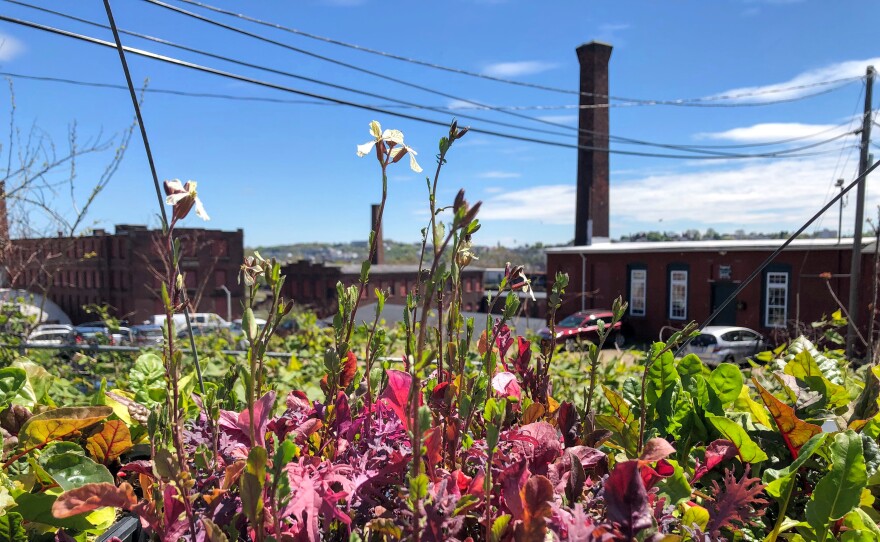For some, urban farms have been a vital source of fresh produce during the pandemic, but that's only one role they play.
Overlooking Worcester, Massachusetts, the Regional Environmental Council operates an urban farm in the city’s Main South neighborhood, squeezed between recently built or renovated homes, apartment buildings and old brick factories. A high tunnel greenhouse currently contains tomato plants. Outside, plenty of birds sing and flats of young lettuce and other baby plants soak up the May sunshine.
Sara Shostak, a medical sociologist at Brandeis University, studies the social production of health and illness. Her latest book is titled, “Back to the Roots: Memory, Inequality, and Urban Agriculture."
Sara Shostak, author: I want to start by saying how much I learned from listening to urban farmers and gardeners across Massachusetts. I didn't set out to write a book about memory, and what I heard and learned was how much memory is a part of urban farming, not because farms and gardens commemorate events, per se, but because they help to keep vital and important cultural traditions alive.
Those include cultural traditions linked to food — practices of cultivation, as well as practices of food preparation, cultural traditions around herbs and healing. I heard a lot about how important it was to reclaim knowledge that they remember their grandmothers or even their great-grandmothers having about how herbs can help keep us healthy.
And it also involves lifting up difficult histories and making them available for processes of consideration, processes of reparation. So even as gardeners are reclaiming these important traditions, they're also critiquing the social processes and the injustices that over time have in some cases severed and in some cases disrupted those traditions.
Carrie Healy, NEPM: So you're saying all of that is going on right here, around us. We're standing in a high tunnel. That's what's happening here?
I think part of what's so exciting and, to my mind, amazing, about urban farming is how much happens alongside growing food. So I really want to honor how much food is grown, right? Especially right here where we're standing, the Worcester Regional Environmental Council, where we are, did an extraordinary, a breathtaking job of responding to the urgent needs for food that emerged in this community during the pandemic.
And, even as they grow all of this food, come up with ways to distribute it safely, to make healthy food accessible to low income families and individuals, there is a lot of work going on as well around developing youth as leaders who have important insights and things to say and things to do about the future of their cities.
You know, some of my colleagues have raised important questions about whether we ask urban agriculture to do too much, and those are important questions. At the same time, it is really impressive how much does get accomplished at these sites.
Many of the sites that you studied and included in the book also did that same kind of work. What are some of the ways to measure what comes out of an urban farm?
Yes, as I was concluding the research for the book, I started another project at the request of urban farming leaders and advocates in Massachusetts. What we found in, first, doing in-depth interviews with urban farming leaders, and then doing two pilot projects with urban farming organizations, Gardening the Community in Springfield and the Urban Farming Institute in Boston, and then doing a survey of an even wider number of urban farming organizations in the state, is that there's a pretty profound mismatch right now between what urban agriculture organizations are typically asked by their funders to measure and how they understand their missions.
So, for many urban farming organizations, their missions are really about social justice, broadly defined. So that includes food justice. It includes environmental justice. It includes youth development and leadership. It includes creating jobs in their communities. And what they're most often asked to measure are how many pounds of food they grew when how many volunteers showed up on site.
I hope we're sort of moving towards a moment where urban agriculture organizations are given more autonomy to define what success means for them. Because it does — obviously, right, we're surrounded by tomato plants — it means growing food, but it also means meaningful progress towards goals like health equity and racial justice in their communities.
When aquaponics came on the scene, it enveloped all the headlines. But, yet, there were still people who were planting tomatoes in the ground at places like this.
And aquaponics is cool. Hydroponics are cool. I met youth out in Holyoke who felt really strongly that they didn't want to have to choose, right? They want to be able to grow hydroponically, and they want to be able to grow at La Finca, which is the larger of the sites cultivated by Nuestras Raíces. And I love their enthusiasm for both. And I also heard from lots of people that we need to think seriously about the upfront capital investments required by indoor growing systems.







![A mural that says "Keep it Going [...] Keep it Growing" is painted on the side of the cinderblock building beside the compost at the Regional Environmental Council in Worcester, Massachusetts.](https://npr.brightspotcdn.com/dims4/default/ad72aa4/2147483647/strip/true/crop/4032x2483+0+160/resize/880x542!/quality/90/?url=http%3A%2F%2Fnpr-brightspot.s3.amazonaws.com%2F1d%2F72%2F9dc45c8d4428a76054f9a0404232%2Fimg-9471.jpg)








